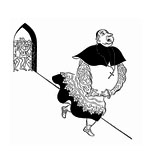
More Magical Moments With Our Bishops
THE USCCB'S 'MINISTRY TO PERSONS WITH HOMOSEXUAL INCLINATION'
Magicians practice sleight of hand or misdirection as part of their stock-in-trade. So does the United States Conference of Catholic Bishops (USCCB). The adoption of the USCCB document “Ministry to Persons with a Homosexual Inclination: Guidelines for Pastoral Care” at the bishops’ annual fall meeting held in Baltimore from November 13-16, 2006, is a case in point.
How the USCCB was able to pull off yet another amazing feat of prestidigitation on behalf of the Homosexual Collective within the U.S. Church is the main theme of this article. But first, some background on the origins and content of the bishops’ Guidelines.
While much of the background on the Guidelines remains shrouded in bureaucratic mystery, we do know that the document on homosexual ministries originated with the USCCB Committee on Doctrine sometime in late 2002.
“Gay”-friendly Archbishop William Levada of San Francisco, the modern city of Sodom, was elected Chairman of the Committee on Doctrine at the November 2002 meeting of the USCCB. He is credited with being the main architect of the Guidelines and with shepherding them successfully through the intricate labyrinth of the bishops’ bureaucracy. Although Levada resigned his office in August 2005 to accept his new appointment to the Roman Curia as Prefect of the Congregation for the Doctrine of the Faith, he continued to exercise control over the final content and direction of the Guidelines from behind the scenes.
You May Also Enjoy
Just as blasphemers assault faith, sodomites assault family life, a foundation of the community.
At a Christian university, students and faculty should be committed to a search for the truth about the truly good life for man.
Is Christianity Today going homosexualist?

